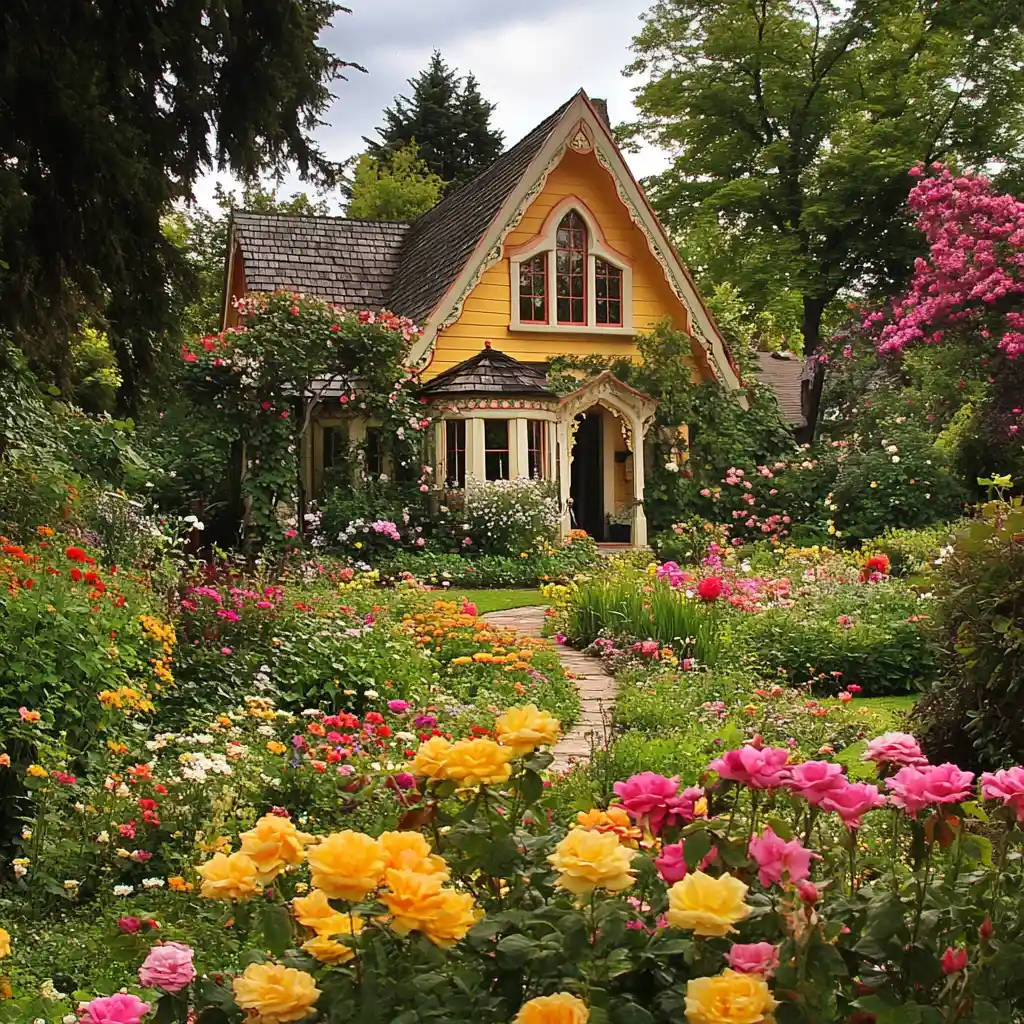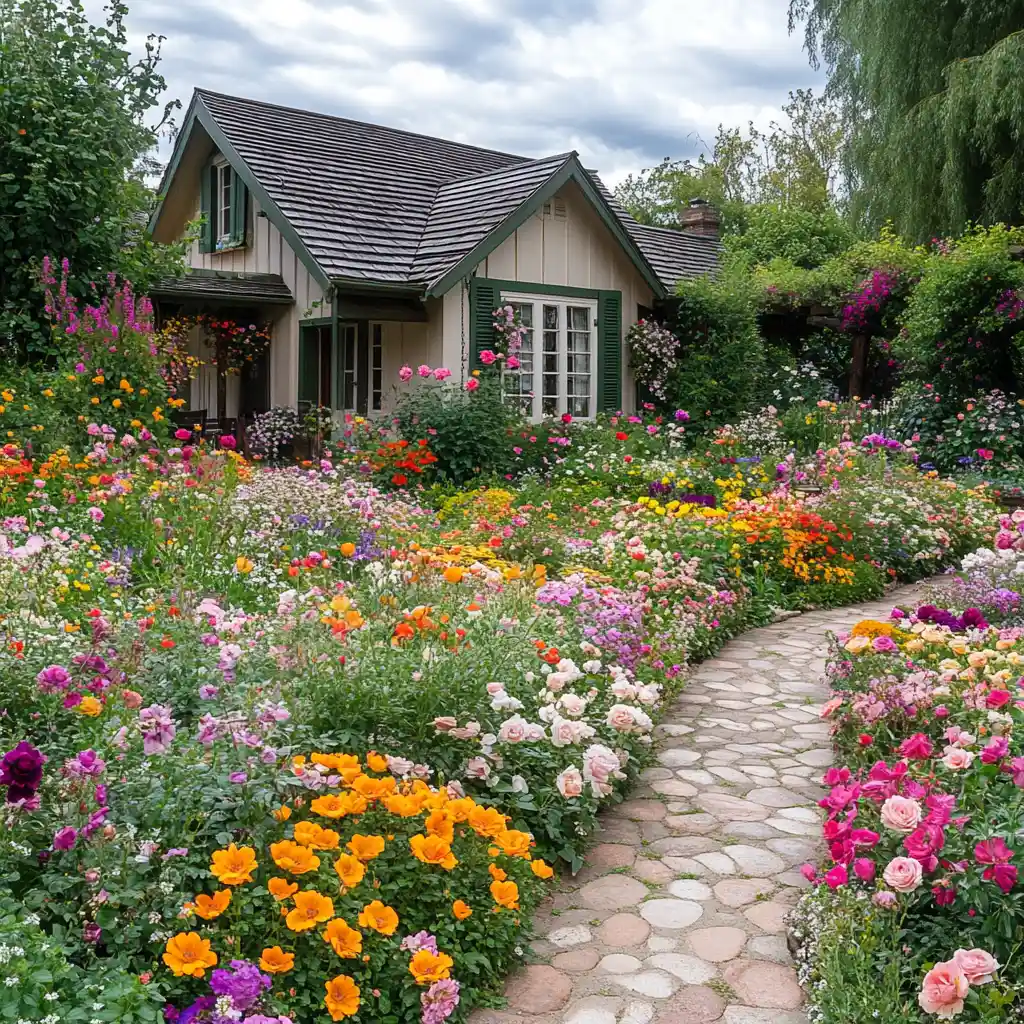Designing a flower garden in a small space is a rewarding blend of creativity and smart planning. With the right layout, color palette, and plant selection, small garden design can turn even a balcony or patio into a lush, fragrant escape. It’s about using every inch wisely—balancing form and function while supporting biodiversity.
If you’re looking for beginner-friendly inspiration, explore these creative small yard landscaping ideas and full-sun flower bed tips that work beautifully in compact spaces. With smart small garden design, even the tiniest plot can thrive all year long.
Table of Contents
Why Create a Flower Garden?
A flower garden is more than a patch of blooms—it’s a living expression of your personality and a deeply rewarding hobby. For those with limited outdoor space, small garden design becomes a unique opportunity to get creative. Each container, bed, or border can be curated to bring joy, calm, and vibrant energy to your daily life.
Designing a flower garden—even a modest one—serves many purposes:
- A creative outlet: Choose colors, shapes, and structures that reflect your artistic flair.
- Therapeutic benefits: Studies show that gardening helps reduce stress, boost mood, and improve mental clarity.
- Pollinator paradise: Even small gardens can support bees, butterflies, and hummingbirds with the right plants.
- Enhanced curb appeal: A beautifully designed small garden adds visual charm to your home’s exterior.
When space is limited, the need for intentionality increases—but so does the reward. With small garden design, every square foot counts, and every bloom has its place.
Benefits of a Well-Designed Flower Garden
Even in the smallest of spaces, a thoughtfully planned flower garden can deliver enormous rewards. Good small garden design doesn’t just enhance the aesthetics of your space—it also promotes personal well-being, supports the environment, and adds functional value to your home.
Here are some key benefits:
- Mental wellness: Tending to a flower garden provides a calming, meditative escape. It’s a simple way to reduce anxiety and bring mindfulness into your day.
- Seasonal color and interest: With a smart plant selection, your small garden can evolve beautifully through spring, summer, and even into fall and winter.
- Eco-boosting habitat: A diverse flower bed encourages pollinators and other beneficial insects, even in compact spaces.
- Increased property value: A tidy, colorful garden—no matter the size—makes your home more attractive to visitors and potential buyers.
- Low-maintenance beauty: With careful planning, small gardens require less effort to maintain while still offering continuous visual rewards.
In short, when done right, small garden design offers big beauty and even bigger benefits.
Common Mistakes to Avoid
Designing a flower garden in a small space comes with its own set of challenges. While enthusiasm is a great start, it’s easy to fall into common traps that can lead to frustration and underwhelming results. Whether you’re a first-timer or looking to refine your approach, avoiding these pitfalls is essential for effective small garden design.
Mistake #1: Ignoring Plant Size at Maturity
That tiny shrub might look perfect today, but many plants quickly outgrow their space. Overcrowding leads to poor air circulation, disease, and a messy appearance.
Tip: Always read plant tags and plan with the mature size in mind—height, width, and spread.
Mistake #2: Choosing the Wrong Plants for Your Zone
Not every flower thrives in every climate. Selecting plants that aren’t suited for your hardiness zone means more maintenance, more disappointment, and less bloom.
Tip: Stick to regionally adapted and native plants for the most success with minimal upkeep.
Mistake #3: Overlooking Year-Round Appeal
Many gardeners focus only on spring and summer flowers, forgetting fall color and winter structure.
Tip: Mix in evergreens, ornamental grasses, and winter-hardy perennials to keep your small garden design visually interesting all year long.
Mistake #4: Neglecting Bloom Succession
If all your plants bloom in one short window, your garden will fade fast.
Tip: Choose a variety of flowers that bloom at different times throughout the seasons.
By keeping these common mistakes in mind, your small garden can stay beautiful, healthy, and full of life—without the headaches.
Planning Your Flower Garden
The secret to a thriving garden isn’t just in the planting—it’s in the planning. For successful small garden design, every decision counts. From choosing the right plants to deciding on layout and color scheme, thoughtful preparation helps you create a cohesive, beautiful space without wasted effort or resources.
Start With a Site Analysis
- Light: Observe how sunlight moves through your space. Is it full sun, partial shade, or mostly shady?
- Soil: Test the pH and texture of your soil. Amend with compost or organic matter as needed.
- Water: Know your watering routine. If your garden is far from a hose, consider self-watering containers or a drip irrigation system.
Define Your Garden Style
Is your vision romantic and cottage-like, or clean and modern? Your preferred style will influence your plant choices, colors, and structural features.
Choose a Color Theme
Cohesive color palettes—like purples and silvers or vibrant pinks and yellows—create harmony in tight spaces. Monochromatic schemes can also make a small garden design feel larger and more intentional.
Sketch a Layout
Even a rough drawing can help. Arrange plants by height and spacing, and think about:
- Walkways or stepping stones for access
- Focal points like containers or art
- Views from windows, balconies, or patios
A clear plan gives your garden purpose, balance, and ease of maintenance—especially important when space is limited.
Choosing the Right Location
When space is tight, selecting the ideal location becomes even more important. In small garden design, the right spot can mean the difference between lush blooms and underwhelming growth. The goal is to align your plant choices with the micro-conditions of your space—especially sunlight, wind, and access to water.
Key Considerations:
- Sunlight:
Most flowering plants need 6–8 hours of sunlight daily. Track how the sun moves through your garden over the course of a day before choosing plants. Partial or full shade? Opt for impatiens, hostas, or ferns. - Shelter from Wind:
Small gardens near buildings or fences may create wind tunnels or drafts. Use trellises, hedges, or tall grasses to shield fragile plants. - Visibility and Access:
Choose a location that’s easy to reach and enjoy—perhaps along a walkway, near your kitchen window, or just outside your patio. The best small garden design places beauty where you can see it every day. - Drainage:
Avoid low spots that stay soggy. If water tends to pool, consider raised beds or containers with good drainage holes.
Even in a compact space, a well-chosen location sets the foundation for a thriving and low-maintenance garden.
Soil Quality and Drainage
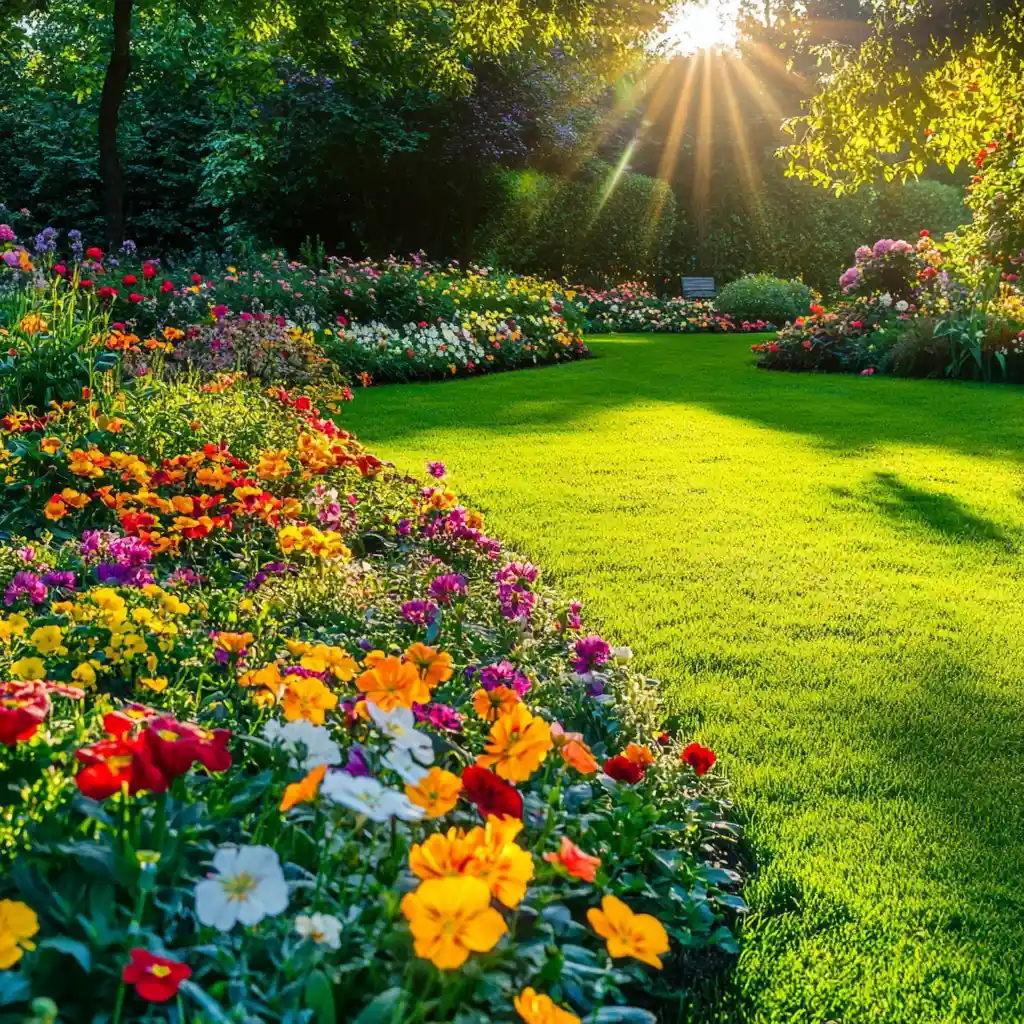
Healthy soil is the heart of any successful flower garden, but it’s especially crucial in small garden design where space (and second chances) are limited. Whether you’re working with ground-level beds, raised planters, or containers, getting your soil right ensures your plants will thrive from the start.
Step 1: Test and Amend Your Soil
- Check pH and texture: Use a home soil test kit to determine pH levels and assess if your soil is sandy, clay-heavy, or loamy.
- Amend as needed: Most flowers prefer well-draining, nutrient-rich soil. Add compost, aged manure, or organic matter to improve structure and fertility.
Step 2: Improve Drainage
Poor drainage can lead to root rot—a common problem in tight spaces. Here’s how to prevent it:
- Use raised beds or containers: These offer excellent drainage control and flexibility in small garden design.
- Add organic material: Compost and sand improve soil structure and help water flow freely.
- Avoid compacted soil: Loosen soil before planting to encourage root expansion and moisture movement.
Step 3: Consider Irrigation Options
While watering by hand is manageable in small spaces, you can save time and conserve water by installing:
- Drip irrigation systems
- Soaker hoses
- Self-watering containers
Good soil and proper drainage set the stage for lush, healthy growth—no matter how small your space may be.
Space and Layout Planning
When working with a compact garden area, every inch matters. Smart small garden design means creating flow, structure, and balance—without overcrowding your plants or overwhelming the eye. With thoughtful layout planning, even the tiniest space can feel spacious and curated.
Design Principles for Small Spaces:
- Leave Room to Grow
Plants need breathing room to thrive. Account for their full mature size—not just how they look in the pot. Spacing also reduces competition for water and nutrients. - Use Vertical Space
Trellises, hanging baskets, stacked planters, and wall-mounted pockets help you grow upward instead of outward. This is a top trick in small garden design for balconies, patios, or side yards. - Layer for Depth
Arrange plants by height:- Tall plants in the back or center
- Mid-size perennials in the middle
- Low growers and groundcovers in the front or around edges
This layering creates a tiered, full look that feels natural and organized.
- Create Movement and Flow
Add stepping stones or mulch paths for easy access and visual interest. Paths don’t just lead you through the garden—they help define space and function. - View from All Angles
Think about how your garden will be viewed: from a kitchen window, a patio chair, or a sidewalk. Rotate pots seasonally or shift focal points to refresh the space throughout the year.
When designed with intention, a small garden feels anything but small—it becomes a layered, immersive experience.
Selecting Flowers for Your Garden
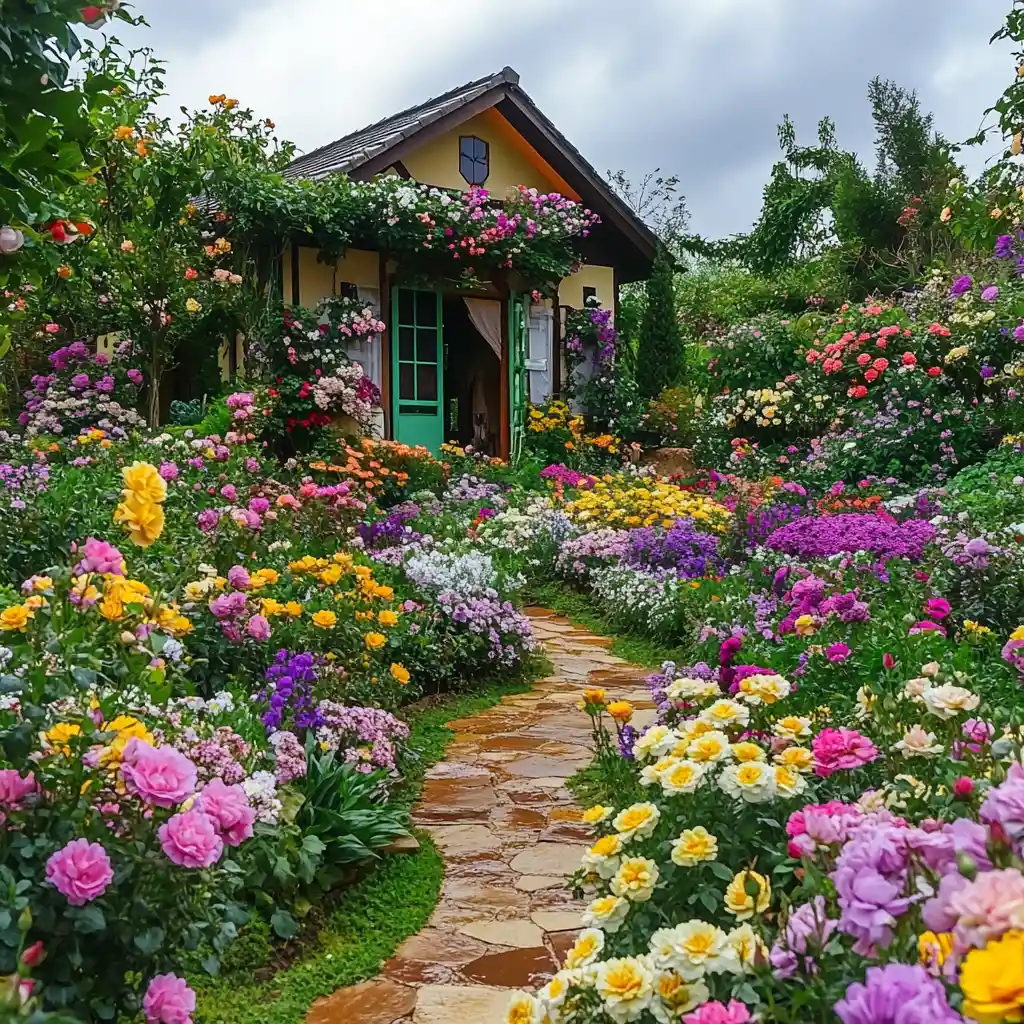
The flowers you choose will define the personality, color palette, and seasonal rhythm of your space. In small garden design, every plant should serve a purpose—whether it’s attracting pollinators, adding fragrance, or filling in texture and color. Since space is limited, your flower choices should be both strategic and stylish.
What to Consider When Choosing Flowers:
- Color Harmony
Stick to 2–3 complementary shades for visual unity. Too many clashing colors can feel chaotic in a small space. Think lavender and white, or coral and soft yellow for a peaceful aesthetic. - Bloom Time
Choose a mix of early, mid-season, and late bloomers to maintain color throughout the growing season. Aim for succession planting so there’s always something flowering. - Texture & Shape
Mix spiky flowers (like salvia), rounded blooms (like zinnias), and airy fillers (like baby’s breath) to create visual balance and avoid flatness. - Scent
With limited space, scent becomes more concentrated. Add fragrant flowers like sweet alyssum, lavender, or dianthus near seating areas or windows to enhance enjoyment. - Pollinator-Friendly Options
Support bees and butterflies with nectar-rich flowers like echinacea, bee balm, cosmos, and milkweed—especially native varieties suited to your region.
Pro Tip for Small Garden Design:
Use repeating plants (the same flower or color group) in multiple spots. This creates visual flow and makes your small garden look cohesive and thoughtfully arranged.
Perennials vs. Annuals
One of the key decisions in small garden design is choosing between perennials and annuals—or finding the right mix of both. Understanding their differences helps you create a garden that delivers color, structure, and low-maintenance appeal throughout the growing season.
What Are Perennials?
Perennials are plants that come back year after year, often blooming for a specific season before going dormant. Examples include:
- Lavender
- Coneflower
- Daylilies
- Hostas (great for shade)
Pros:
- Long-term investment
- Low maintenance after establishment
- Provide structure and consistency
Cons:
- Shorter bloom periods for some varieties
- May take a season or two to reach full potential
What Are Annuals?
Annuals complete their life cycle in one season. They’re known for vivid colors and constant blooms.
Common examples:
- Petunias
- Marigolds
- Zinnias
- Nasturtiums (which also work well in containers)
Pros:
- Instant impact
- Long blooming period
- Ideal for filling gaps or seasonal displays
Cons:
- Need to be replanted each year
- Can be more expensive over time
Smart Strategy for Small Gardens
In small garden design, combining both types gives you the best of both worlds:
- Use perennials for structure and reliability
- Use annuals for rotating pops of seasonal color and flexibility
Containers and border areas are ideal for experimenting with annuals while relying on a backbone of hardy perennials elsewhere.
Color and Bloom Time Coordination
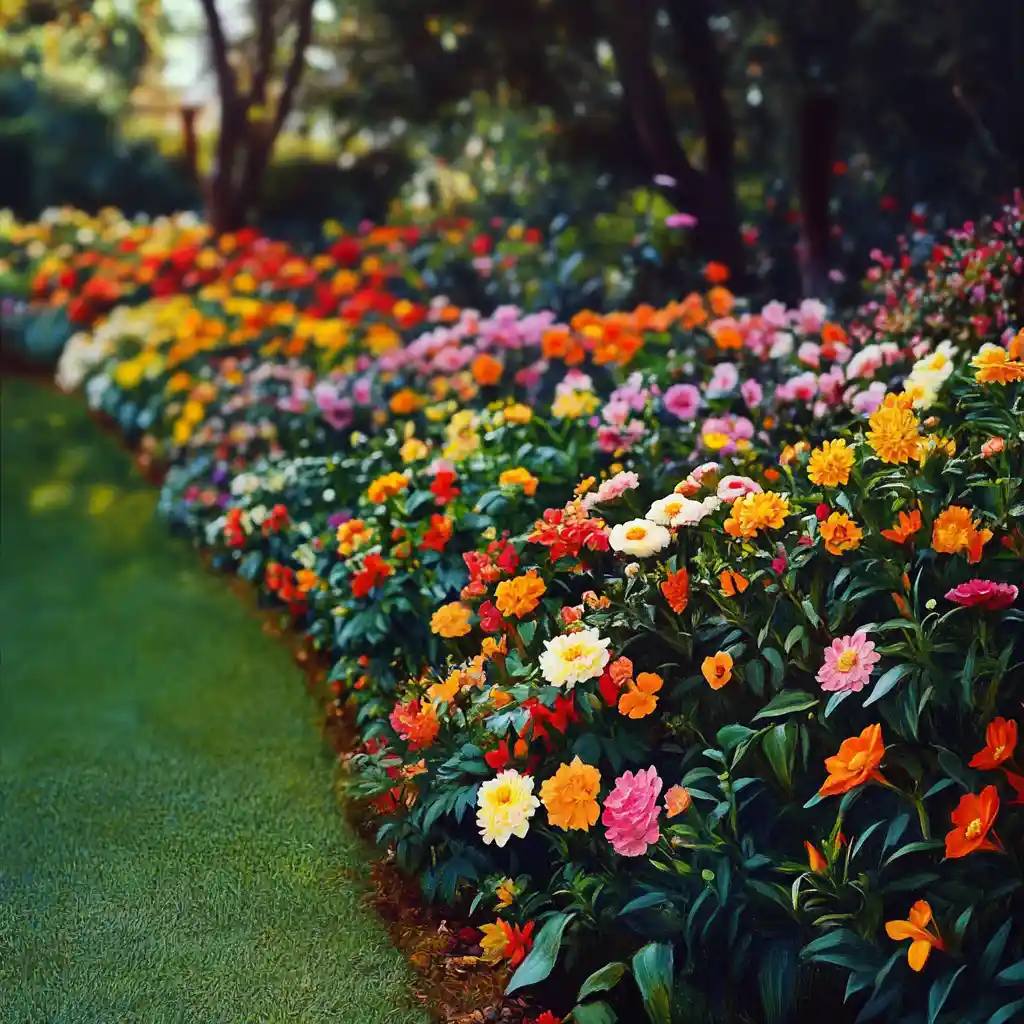
One of the most rewarding aspects of flower gardening is crafting a palette that evolves beautifully through the seasons. In small garden design, where space is limited and every bloom counts, thoughtful coordination of color and bloom time ensures your garden stays dynamic, cohesive, and continuously eye-catching.
Creating a Color Scheme
Too many contrasting hues in a tight space can feel overwhelming. Instead, choose a focused approach:
- Complementary Colors: Opposites on the color wheel, like purple and yellow or blue and orange, create vibrant contrast.
- Analogous Colors: Neighbors on the color wheel—like pink, red, and orange—offer a softer, blended look.
- Monochromatic Scheme: A single color in varying shades (like pale pink to deep rose) feels serene and sophisticated.
Tip: Repeat your main color in various parts of the garden to create unity and make the space feel larger.
Stagger Bloom Times
To keep your garden from peaking all at once and fading early, select flowers that bloom in stages:
- Early bloomers: Crocus, tulips, pansies
- Mid-season stars: Daisies, coneflowers, coreopsis
- Late-season interest: Sedum, asters, ornamental grasses
Use tags, seed packets, or online guides to map out bloom periods. When bloom times are staggered effectively, your small garden design will maintain color and vitality from early spring to first frost.
Incorporating Fragrance
When working with limited space, you want every element of your garden to serve multiple purposes—and fragrance is one of the most impactful yet subtle additions. A well-scented small garden design can transform a compact area into a multi-sensory retreat, evoking calm, nostalgia, or even energy, depending on the plants you choose.
Best Fragrant Flowers for Small Gardens
- Lavender – Iconic, calming, and drought-tolerant
- Roses – Old-fashioned varieties like ‘David Austin’ offer heady scents
- Sweet Alyssum – Compact, honey-like fragrance, great for edging
- Jasmine – Ideal for trellises or containers in warm climates
- Dianthus (pinks) – Clove-scented and low-growing
Placement Tips for Maximum Impact
- Near seating areas: Enjoy the aroma while relaxing outdoors
- Beside walkways: Release fragrance with every brush as you pass
- Close to windows or doors: Bring the scent indoors naturally on a breeze
Keep It Balanced
In small spaces, avoid mixing too many strong fragrances—especially contrasting ones like rose and citrus. Choose 1–2 signature scents and repeat them throughout your design for a cohesive sensory experience.
Adding fragrance elevates your small garden design from something you see to something you truly experience.
Native & Pollinator-Friendly Flowers
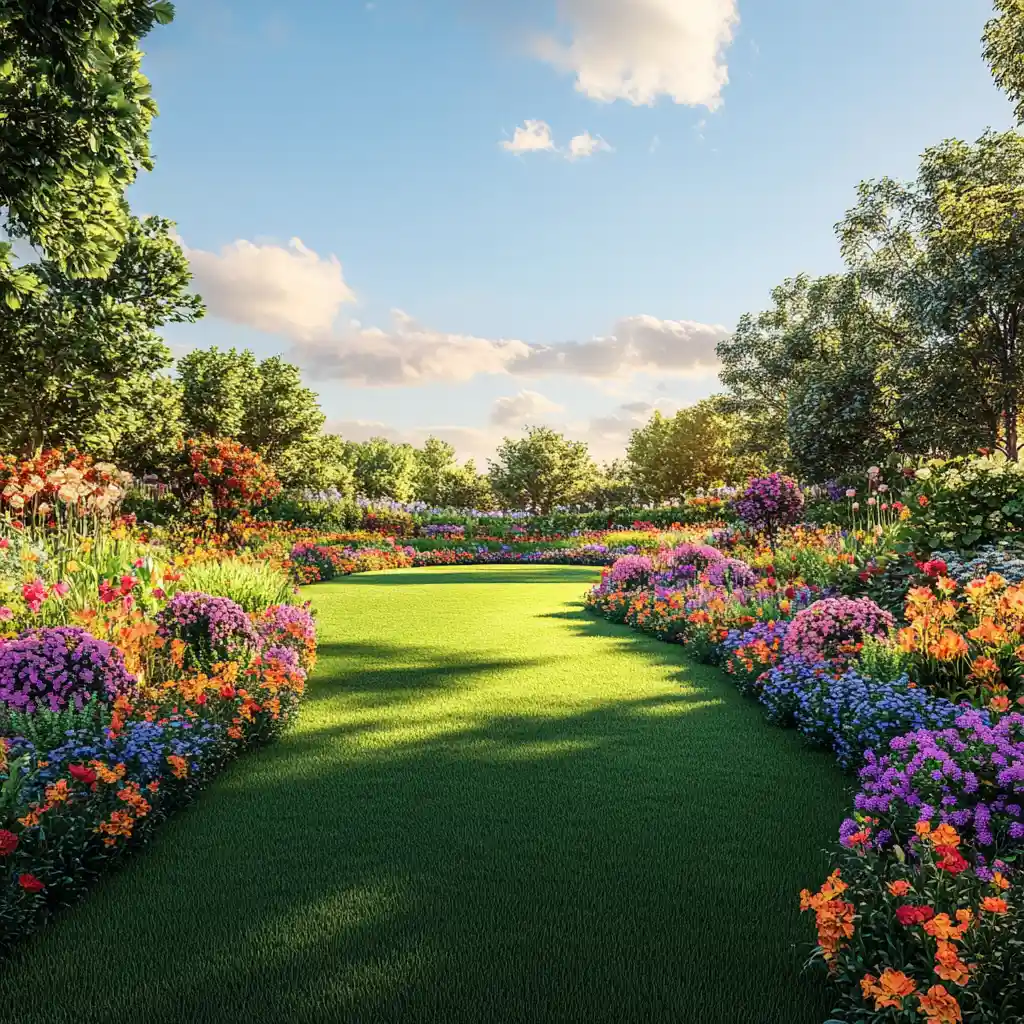
Incorporating native and pollinator-friendly flowers into your small garden design isn’t just environmentally responsible—it’s also practical and visually rewarding. These plants are adapted to your local climate, generally require less maintenance, and attract beneficial pollinators that support the health of your entire garden ecosystem.
Why Choose Native Plants?
- Adaptability: Thrive in your region’s soil, climate, and rainfall patterns
- Low Maintenance: Less need for fertilizers, pesticides, and constant watering
- Resilience: Better resistance to local pests and diseases
- Wildlife Support: Provide food and habitat for local birds, bees, butterflies, and beneficial insects
Pollinator Favorites for Small Spaces
- Echinacea (Coneflower) – Hardy, long-blooming, and bee-attracting
- Milkweed – Essential for monarch butterflies
- Black-eyed Susan – Bold color and great nectar source
- Bee Balm – Bright, fragrant blooms that attract bees and hummingbirds
- Coreopsis – Cheerful daisy-like flowers with high nectar output
Smart Integration in Small Gardens
In compact spaces, it’s important to blend form and function:
- Use native flowers as border plants or in container arrangements
- Mix them with perennials or ornamental grasses for texture
- Choose compact cultivars of native species where possible
By making room for even a few native or pollinator-friendly blooms, your small garden design becomes a haven not just for you—but for the local ecosystem, too.
Designing the Garden Layout
Layout is where creativity meets functionality. In small garden design, the way you arrange your plants and features directly affects how spacious, harmonious, and inviting the garden feels. A smart layout allows for easy movement, focal points, and year-round visual interest—without crowding or clutter.
Establish a Focal Point
A focal point draws the eye and adds structure to the space. Even in a small garden, this could be:
- A sculptural planter or large flowering shrub
- A decorative bench or garden statue
- A small water feature like a birdbath or fountain
Position your focal point where it’s naturally visible—such as at the end of a path or centered in a raised bed.
Layering for Dimension
To avoid a flat, one-note look, use layering techniques:
- Tall plants in the back (or center if it’s a round layout)
- Mid-sized perennials in the middle
- Low growers and groundcovers in front
This approach adds depth and ensures every plant is visible, even in tight spaces.
Incorporate Structures Wisely
Vertical elements are a hallmark of great small garden design:
- Trellises and arbors support climbing plants and add height
- Benches or containers on pedestals break up the eye line and invite interaction
- Garden mirrors or reflective surfaces can even make your garden appear larger
Paths, edging, and design symmetry—such as repeating colors or shapes—help define the space and make it feel intentional rather than crowded.
By approaching layout with a mix of structure and softness, your small garden becomes both beautiful and practical.
Planning for Year-Round Interest
A common mistake in gardening—especially in small spaces—is focusing only on peak bloom seasons. But with a bit of foresight, your small garden design can deliver color, texture, and beauty in every month of the year. The key is layering plants for seasonal succession and incorporating elements that shine even when flowers fade.
Spring
- Bulbs: Tulips, crocus, and daffodils provide early color
- Flowering shrubs: Forsythia or dwarf lilac bring vibrant structure
- Cool-season annuals: Pansies, snapdragons, and violas add cheer
Summer
- Perennials: Coneflowers, salvias, and black-eyed Susans are low-maintenance staples
- Annuals: Zinnias and marigolds give continuous blooms
- Climbers: Morning glories or clematis offer vertical flair
Fall
- Foliage plants: Ornamental grasses and heuchera add color and motion
- Late bloomers: Sedum, asters, and Japanese anemones extend the flowering season
- Texture: Seed heads and dried flowers contribute to fall interest
Winter
- Evergreens: Boxwood, dwarf conifers, or rosemary provide year-round structure
- Decorative elements: Pots, trellises, or hardscape features remain visually appealing even when bare
- Berries: Plants like winterberry or holly attract birds and add bright pops of red
By combining evergreen structure with seasonal rotation, your small garden design won’t just look good—it’ll evolve gracefully and keep offering something new all year long.
Planting & Care Essentials
Even the most beautifully designed garden needs regular care to stay healthy and vibrant. In small garden design, these tasks are easier to manage, but they’re also more noticeable when skipped. With the right planting techniques and ongoing maintenance, your garden will flourish with less effort and more reward.
Planting Tips for Success
- Dig Smart: Make your hole twice as wide as the root ball and just as deep. This gives roots room to spread without sinking.
- Handle Gently: Remove plants from containers by squeezing the sides—not pulling the stem—and loosen tangled roots before placing in the soil.
- Water Deeply: Water right after planting to settle the soil and eliminate air pockets. This helps roots establish quickly.
Watering Strategies
- Consistent Moisture: Most flowering plants prefer evenly moist soil—not soggy or bone dry.
- Time It Right: Water early in the morning or late in the day to reduce evaporation.
- Use Efficient Methods: Soaker hoses or drip systems are perfect for small gardens, especially in containers or tight beds.
Mulching Matters
- Moisture Retention: Mulch helps lock in soil moisture—especially helpful in raised beds or sunny patios.
- Weed Suppression: A 2–3 inch layer of organic mulch keeps weeds at bay.
- Soil Temperature: Mulch protects roots from extreme temperature swings.
Fertilizing for Growth
- Compost First: Enrich your soil with organic matter before reaching for synthetic fertilizers.
- Slow and Steady: Use slow-release or balanced fertilizers to provide nutrients throughout the season.
- Don’t Overdo It: Too much nitrogen leads to lush leaves but fewer flowers—especially in tight spaces where balance is key.
Ongoing Maintenance
- Deadheading: Remove spent blooms to encourage more flowers.
- Pruning: Shape plants, remove dead growth, and promote air circulation.
- Weeding: Stay on top of weeds while they’re small—it’s easier and keeps your garden neat.
Regular attention ensures your small garden design remains vibrant, balanced, and low-stress to manage—leaving more time to enjoy the blooms.
Decorative Additions
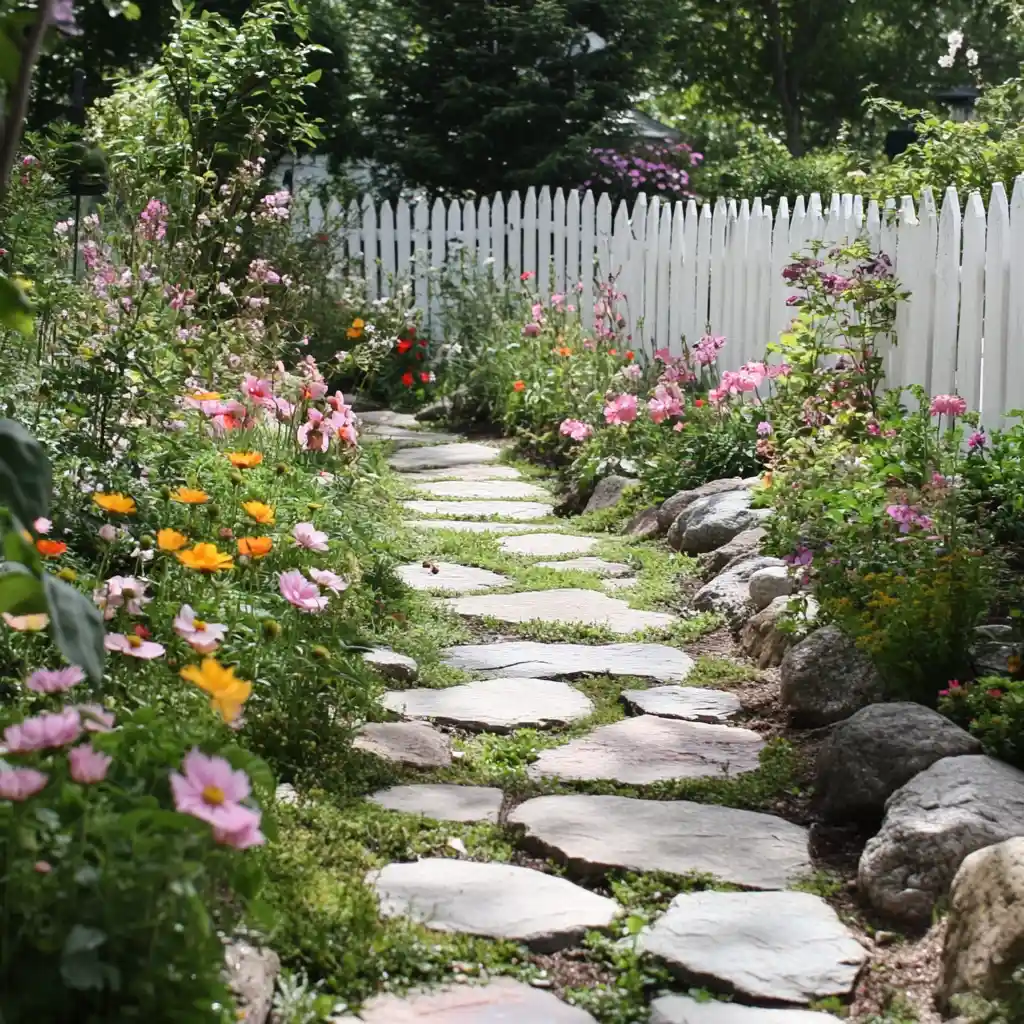
Incorporating decorative elements into your small garden design is where creativity truly takes root. These features not only reflect your style, but also bring structure, movement, and visual interest—especially valuable in smaller spaces where every item makes an impact.
Garden Art & Sculptures
Add personality and character to your garden with artful touches:
- Statues or figurines: Use as focal points in bare corners
- Recycled materials: Repurposed metal, driftwood, or pottery bring texture and storytelling
- Wind chimes or mobiles: Add sound and subtle movement
Tip: Choose pieces that complement your garden’s style—rustic, modern, whimsical, or natural.
Pathways & Edging
Even in a compact garden, defined paths and borders offer function and form:
- Pathways: Use gravel, brick, or stepping stones to guide movement and divide space
- Edging: Define beds with stone, wood, or metal for a tidy, finished appearance
Clear lines and gentle curves help your small garden feel intentional, not cluttered.
Water Features
A little water goes a long way in enhancing serenity:
- Birdbaths: Invite feathered visitors while adding vertical interest
- Mini fountains: The sound of trickling water calms and masks noise
- Reflective bowls or pebbled basins: A stylish, space-efficient option
Mirrors and Illusions
Strategically placed garden mirrors or polished metal can reflect light and greenery, making your small garden design feel twice the size.
Decorative elements are more than accessories—they’re essential tools to balance form, function, and personality in your outdoor retreat.
Lighting Your Flower Garden
Incorporating lighting into your small garden design not only adds beauty after dark—it also enhances safety, creates mood, and highlights your garden’s best features. Even the smallest space can feel magical with the right light placement.
Types of Garden Lighting
- Path Lights: Line walkways or edges of beds for safe navigation and gentle illumination
- Spotlights: Highlight a focal plant, sculpture, or water feature
- String Lights: Drape over trellises, fences, or pergolas for a cozy, festive feel
- Solar Lights: Eco-friendly, wire-free, and perfect for small, off-grid areas
Where to Place Garden Lights
- Near seating areas: Create a warm ambiance for evening relaxation
- At focal points: Draw attention to a favorite flower bed or garden art
- At entrances or along boundaries: Provide subtle definition and orientation
Light Temperature & Mood
- Use warm white bulbs (2700K–3000K) for a welcoming, natural glow
- Avoid harsh or colored lighting that can overpower your flowers and space
Lighting doesn’t just serve a functional role—it turns your small garden design into an enchanting nighttime retreat, perfect for evening dinners, stargazing, or simply unwinding after a long day.
Seasonal Flower Garden Care
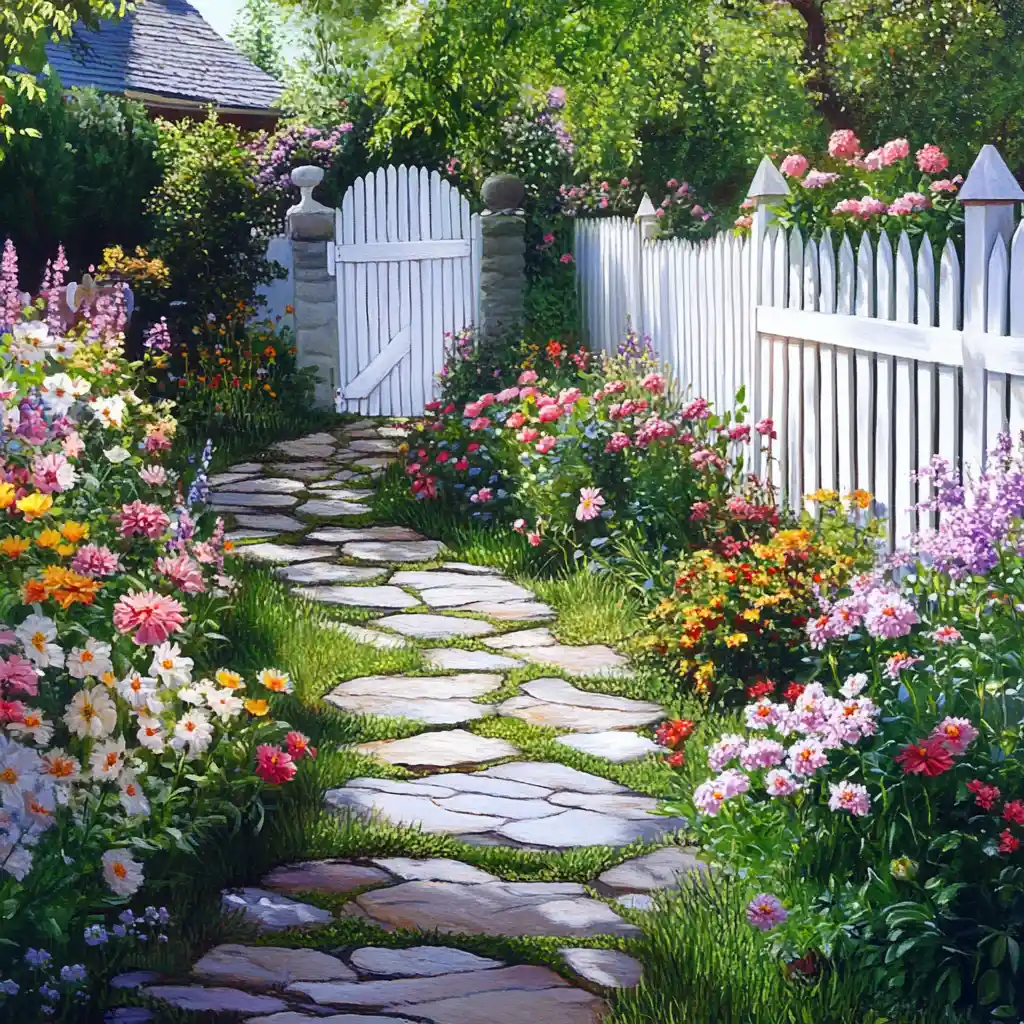
A beautiful garden isn’t just planted—it’s nurtured through the seasons. With small garden design, seasonal care is manageable and often more enjoyable, allowing you to stay connected with your space year-round while preventing big problems from building up.
Spring: Fresh Start
- Clean up: Remove dead leaves, debris, and winter mulch
- Soil prep: Add compost and test pH levels
- Planting: Sow cool-season annuals and transplant perennials
- Divide and conquer: Split overcrowded perennials to refresh growth
Summer: Peak Performance
- Water wisely: Deep, consistent watering—preferably in the morning
- Deadhead regularly: Encourage new blooms by removing spent flowers
- Fertilize: Use balanced or slow-release fertilizer to support growth
- Watch for pests: Inspect leaves and stems weekly for bugs or mildew
Fall: Wind Down & Rebuild
- Prune and cut back: Trim perennials and remove dead annuals
- Plant bulbs: Add spring-blooming bulbs like tulips and daffodils
- Mulch: Add a fresh layer to protect roots from temperature swings
- Collect seeds: Save seeds from your favorite flowers for next season
Winter: Rest and Reflect
- Protect tender plants: Use frost cloth or move containers indoors
- Maintain structure: Evergreen shrubs or decorative elements keep visual interest
- Plan ahead: Sketch layout changes or research new plant varieties
- Clean tools: Sharpen, oil, and organize garden tools for spring
With just a little seasonal attention, your small garden design will remain a vibrant, evolving space you can enjoy in every weather and every mood.
FAQ
1. What are the best beginner flowers for a small garden?
Great options include marigolds, zinnias, lavender, sweet alyssum, and cosmos. They’re easy to grow, low-maintenance, and perfect for adding color to containers or borders.
2. How do I choose the best location for my flower garden?
Look for a spot with 6–8 hours of sun, good drainage, and easy access to water. For shaded spaces, choose plants like hostas or impatiens that thrive in lower light.
3. What’s the difference between annuals and perennials?
Annuals bloom for one season and must be replanted yearly. Perennials return year after year and usually require less maintenance once established. Use both to balance color and longevity.
4. How can I make my small garden look bigger?
Use layering, mirrors, vertical structures, and a consistent color palette to create depth and flow. Repeating shapes and plant types also helps make the space feel cohesive and larger.
5. What’s a good way to attract pollinators in a small garden?
Plant nectar-rich flowers like bee balm, lavender, coneflowers, and milkweed. Stick with native species when possible—they’re best adapted for supporting local bees and butterflies.
6. How do I avoid overcrowding in small garden design?
Always plan for a plant’s mature size, not how it looks in the pot. Leave breathing room for airflow and access. Raised beds and containers can help organize limited areas.
7. What’s the benefit of using mulch in flower beds?
Mulch helps retain moisture, suppress weeds, moderate soil temperature, and improve soil structure as it breaks down. It’s essential for low-maintenance success in any garden size.
Conclusion
Designing a flower garden doesn’t require sprawling land or professional training—it simply takes vision, care, and creativity. With thoughtful planning, layered plant choices, and a few personal touches, your small garden design can deliver big beauty, relaxation, and joy throughout every season.
Whether you’re just starting or refining an existing space, remember: small gardens have the power to inspire, uplift, and connect you with nature—one bloom at a time.

